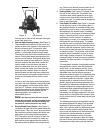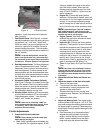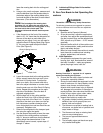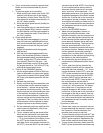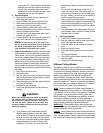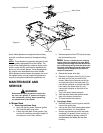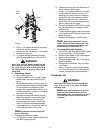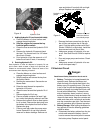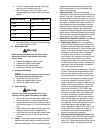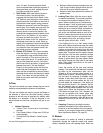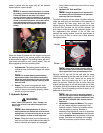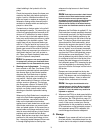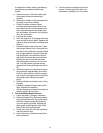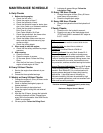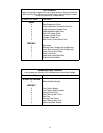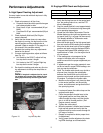
20
b. Clean the battery before storing. A dirty bat-
tery will lose its charge over time.
c. Store the battery with a full charge. A dis-
charged battery will freeze (refer to the table
below).
Specific Gravity Freezing Temp (°F)
1.265 -71
1.250 -62
1.200 -16
1.150 5
1.100 16
d. Recharge battery when ever the specific grav-
ity value is less than 1.225
3. Battery Removal
Warning:
When removing the cables from the battery follow
these steps to avoid a short between the wrench
and the frame.
a. Remove the Negative (black) cable.
b. Remove the Positive (red) cable.
c. Release the hold down straps.
d. Remove the battery without tipping.
4. Installing the Battery
Note: The battery is delivered from the factory
fully charged and filled with electrolyte.
a. Attach the Positive (red) cable.
b. Attach the Negative (black) cable.
c. Attach the rubber battery strap.
5. Jump Starting
Warning:
Failure to use this starting procedure can cause
sparking, and the gases in the battery to explode.
a. Attach the end of the red jumper cable to the
Positive terminal (+) of the charged battery.
b. Attach the other end of the red jumper cable to
the Positive terminal (+) of the low charge bat
-
tery.
c. Attach the end of the black jumper cable to the
Negative terminal of the charged battery.
d. Attach the other end of the black jumper cable
to the frame of the unit with the low charge
battery.
6.
Fuses:
There are two fuses located in the wiring
between the ignition and start switch and other
electrical components. This is a standard plug-in
type automotive fuse rated at 20 amp for the
main harness and 10 amp for the digital fuel
injector and fuel pump.
7.
Safety Switches:
There are three safety
switches in the electrical circuit which control the
engine. They are (1) the blade clutch switch, (2)
the steering lever/park brake switche and (3) the
seat switch. They operate so that in order to start
the engine, the blade clutch switch must be off,
the parking brake must be engaged, and both
steering levers must be in the neutral position.
Once the engine is started, the seat must be
occupied and the parking brake must be released
before either of the steering levers can be moved.
Also, the seat must be occupied before the blade
clutch switch can cause the blades to rotate.
8.
Safety Switch Operation Checks:
The following
operational checks should be made daily.
a. Blade Clutch Switch: Sit in the operator’s
seat. With both steering levers in the neutral
position and the parking brake engaged, turn
the blade clutch switch “on” and try to start the
engine. The engine should not start. If it does,
the blade clutch switch must be replaced. If
the engine does not start, turn the blade
clutch switch “off” and start the engine. Now
turn the blade clutch switch “on” and the
blades should rotate. If the blades do not turn,
the blade clutch switch must be replaced, the
seat switch must be replaced or the electric
PTO clutch must be repaired.
The air-gap should be checked every 100 hrs.
(or less, if severe operating conditions exist
such as when there are many on/off cycles,
mulching operations, material collection sys
-
tems used, and dusty/dirty conditions), and
the air-gap adjusted if more than 0.025". To
inspect, remove the “negative” cable from the
battery and all sparkplug wires. The air-gap
should be checked with feeler gages in the
three slots of the BBC (PTO Clutch). See
page 24 for air gap adjustment specs. There
are three inspection slots in the brake cover.
To adjust, successively tighten each of the
three gap adjustment nuts an equal amount.
Insert a feeler gage (see page 25 for specs)
into each slot as the air gap adjustment nut
are tightened. The correct adjustment occurs
when slight contact with the feeler gage
occurs. Engage the BBC (PTO Clutch) a cou
-
ple of times, and re-check the air-gap. If it is
not between the specs listed on page 25,
repeat the adjustment procedure.
b. Steering lever/Parking Brake Switch: Sit in
the operator’s seat. With both steering levers
in the neutral position and the blade clutch
switch “off”, release the parking brake and try
to start the engine. The engine should not



